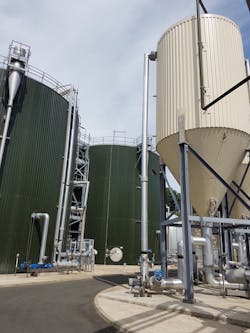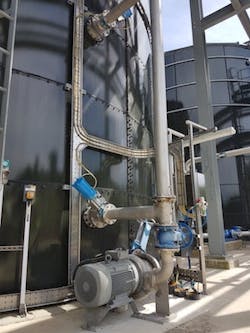About the author:
Chris French is a freelance writer on water, environment and renewable energy issues. French can be reached at [email protected].
Jersey is the largest of the Channel Islands located between England and France. It is known for its Jersey Royal new potatoes, as well as its dairy products from its iconic purebred cattle—and now, for those with an interest in engineering, research, design and efficiency, its sewage treatment works (STW).
Granted, the STW may never feature in any Channel Islands tourism brochure, but as home also to one of the world’s leading international finance centers, Jersey knows how to invest money.
When the time came to replace the sludge plant built in 1959 at the island’s STW to meet future environmental standards (and a population already in excess of 105,000), the customer and the main process engineering contractor soon found that their respective drivers to meet a 2035 design horizon had plenty in common.
Three years on, the plant at Bellozanne, which has at times been carbon neutral, still shines like new. But this is not some strange coincidence, nor is it due to Jersey’s Gulf Stream climate.
From the outset, Jersey’s Department for Infrastructure, together with Doosan Enpure, knew that with the logistical challenges faced by the island, the aforementioned criteria of efficiency, ease of maintenance and high performance were crucial, particularly for the plant’s pumps and
mixing systems. Fog or high winds can stop goods from reaching Jersey, so Bellozanne STW has to be self-sufficient and have backup.
“The new plant gave us the perfect opportunity to engineer out old unwanted problems,” said Bob King, senior engineer of waste strategy – mech and process for the States of Jersey Department for Infrastructure. “Previously, for example, we had an ongoing nightmare with very costly maintenance for compressors, which went down even if there was just a small amount of foam in our old gas mixing system. We also suffered with ragging and problems with pipework and fittings that simply weren’t of a design.”
Keep It on the Outside
Weighing up Bellozanne’s drive toward a highly robust plant where downtime would be a thing of the past, Doosan Enpure also was busy sourcing equipment that would meet requirements, especially for low maintenance.
“We certainly agreed straight away that for the three new anaerobic digesters, all pipework and moving parts should be on the outside of the tank,” said Michelle Macleod, principal mechanical engineer. “Externally-mounted equipment would also improve health and safety by eliminating the need for working at height, and confined space entry.”
Together with Gary Davies, principal engineer at Bellozanne STW, King—who has worked 25 years at the plant—carried out several field trips to research suitable mixers, seeking equipment that also would mix the whole tank rather than systems that provide little or no rotation.
“Eventually we visited Landia in Denmark to see for ourselves,” King said. “As well as seeing the GasMix digester mixing system, the setup and the people was impressive the moment we walked in, which gave us confidence too in the type of service and backup that we were going to get. We didn’t want any breaks that would interfere with our gas production. Lowest possible price wasn’t our objective—not for one second. We were making decisions on what was most appropriate for the long term. A mixing system that could produce the most gas yet be the lowest on maintenance made perfect sense.”
Utilizing its chopper pump to break down particle size, Landia’s GasMix also includes multiple venturi nozzles, depending on requirements.
“Landia were very helpful because we wanted everything at ground level, meaning no access platforms at the side of the tanks—which saves time and money—and putting the solenoid valves that power the pneumatic actuators down to a solenoid box at ground level in an explosion-proof enclosure,” Macleod said. “We also wanted an isolation valve included between digesters and the actuated valve so that we wouldn’t have to decommission an entire digester if we had a problem with a valve. Operating times also came into the decision to choose Landia, rather than systems that run flat out, so in effect, it gives the operator the flexibility and confidence to fine-tune the mixing for maximum gas yields.”
At the old Bellozanne plant, lime that caused a distinctive rotten fish odor was used to enhance the treatment of sludge at a cost of £80,000, but that expenditure has gone. The new pasteurization technology holds the sludge at 55°C for a minimum of four hours prior to passing to the anaerobic digesters.
“As well as the pasteurizers,” Davies said, “the investment in our [combined heat and power (CHP)] sees minimal flaring of gas. It all goes to the CHP, and we can now use the excess heat to heat the sludge. The whole focus of our operation has changed because we look at gas production every day and see how, if possible, we can tweak it to make it better. We might see if we can thicken more, thicken less, change feed rates–look at what is coming in, look at what is being washed away. We’ll never stop wanting to learn and improve.
“Doosan Enpure are very good process people to work with, helping us achieve up to 500 kW of electricity (and the same again in heat)–about £800 to £1,100 per day. The pasteurizers make a big positive difference in presenting the digesters with much better material. Further on in the process, we now have far less grit, silt and rag to deal with. Before we had to take a digester out of service, bring in costly tankers to remove two to three meters of grit, silt and rag, but now we’re very much heading in the right direction.”
One area that required much more than mere fine-tuning was the continuous furring up of the new plant’s heat exchangers, which required weekly cleaning. This conflicted with Bellozanne’s quest for low maintenance.
“Initially we blamed the exchangers, as perhaps most operators do,” King said. “We tried linking them in series, in parallel, but eventually we found the remedy by introducing an air line. Our heat exchangers now have no trouble reaching their required temperatures and require very little in the way of cleaning. The downside to this was additional wear to the pasteurizer mixing pumps, caused by aerated sludge. This issue was addressed by upgrading to hardened impellers to improve service life.”
Bellozanne and Doosan Enpure also chose Landia pumps for three separate tanks containing digested sludge, thickened sludge (fed to the digesters via pasteurizers) and unthickened sludge that comes off the final clarifiers, which is then thickened and added to the thickened tank to maximize overall residence time. As with the Landia chopper pumps on the GasMix systems of the three digesters, none has required any spare parts since being installed three years ago.
Good Mix
Dave Garnett, technical wastewater specialist for Doosan Enpure said Bellozanne is achieving high volatile solids destruction at an average of around 60%.
“The pasteurizers must help, but good mixing is critical with the high temperature feed to the digesters to make sure that everything is distributed properly,” Garnett said. “Landia’s GasMix is working very well indeed because we’re seeing plenty of energy produced by the CHP (that has already more than paid for itself), so making a big reduction in [operating expenses].
“It is interesting that many digesters in the industry run on 2 to 2.5% solids, when with a simple retrofit to a superior mixing system, they could increase to 4% and see an immediate payoff.”
Cake Consistency
“From a process point of view, the good mixing we have here with the Landia equipment is very important for consistency,” Davies said. “It has a very positive knock-on effect all the way through, including that big reduction in grit [and] silt, because we can see that the digesters are being mixed properly.”
Further evidence of the plant’s enviable performance comes in the sludge cake. Without lime, there was some concern initially about how consistent it would be, but according to King, the plant now produces a far better product.
“It is much more appealing to farmers, for whom we now provide technical assistance to help them with spreading compliance, testing their fields for them,” he said. “We still have more we can achieve in this area, but we’ve already come a long way since we used to have to pay farmers to take the treated sludge away.”
Davies added that despite the increased complexity, the changes have saved the plant money.
“Not everybody understands the drivers when being on an island,” he said. “No point supposedly saving £1 million on [capital expenditures] if it’s then going to cost you an extra £3 million in maintenance. This plant’s performance proves that we are winning the argument.”
Doosan Enpure’s MacLeod agrees.
“I’ve never seen such a clean, tidy and well-maintained site, which is highly beneficial for the equipment, run by people who are very knowledgeable about the process—and care about it,” she said.
About the Author
Chris French
Chris French is a freelance writer on water, environment and renewable energy issues. French can be reached at [email protected].

